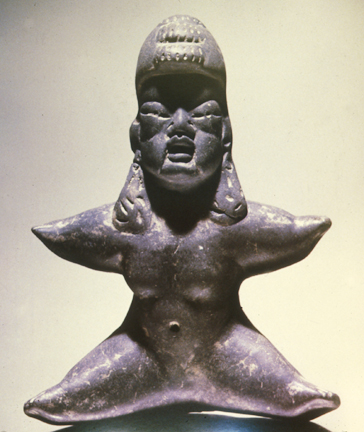The OLMEC culture was the first major Mesoamerican civilization, emerging during the Formative (Preclassic) period along the Gulf of Mexico, in swampy jungles in what are now the states of Veracruz and Tabasco. Clearing the jungle from areas adjacent to the slow, meandering rivers in the area, they cultivated crops and established cities with central structures for their rulers, and outlying villages for the farmers. Findings of jade objects in the Olmec sites indicates an extensive trade system was already in place, because this material is not found locally in Olmec areas. This effigy figure exhibits the classic, exaggerated Olmec features: the swollen eyelids, the wide, flat nostrils, and the unusual forming of the mouth. Such small hand-modeled figures are associated with crop fertility and have been found in large numbers. They probably served the same function as their Mesopotamian counterparts, used to make offerings to ensure good harvests, although this is not known with certainty. Interestingly, the name Olmec was not the name these peoples gave themselves, that name being lost to history. They were named Olmec by George Vaillant, an archaeologist who studied their culture. The Olmec were the main precursor culture to all Mesoamerican cultures to follow, including the Maya and Aztec, who referred to them over 2000 years later as the people of the legendary lands of Tamoanchan, on the Easter Sea (the Gulf of Mexico), and the only written reference to them is in Nahuatl, the language of the Aztec:
'in a certain era
which no one can remember
which no one can reckon
thre was a government for a long time. . . '

Seated Child, Effigy Figure, Earthenware
Preclassic period, Olmec culture, 1,000-800 BCE


